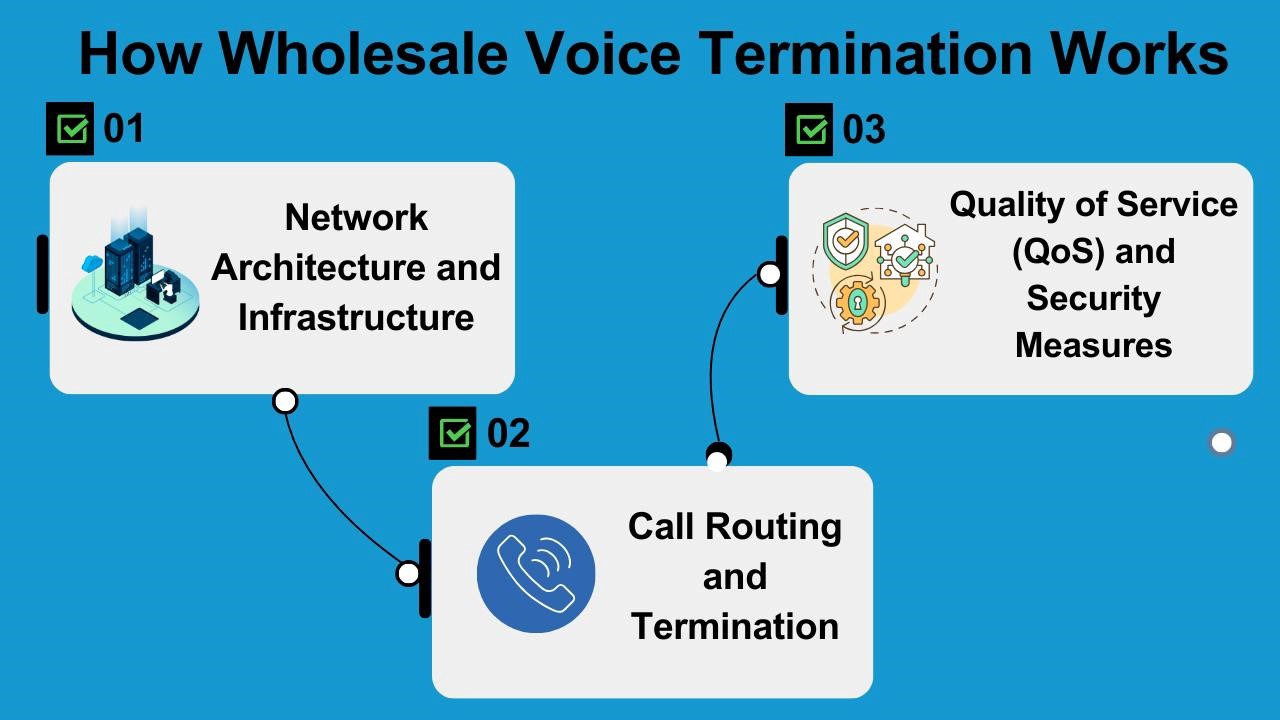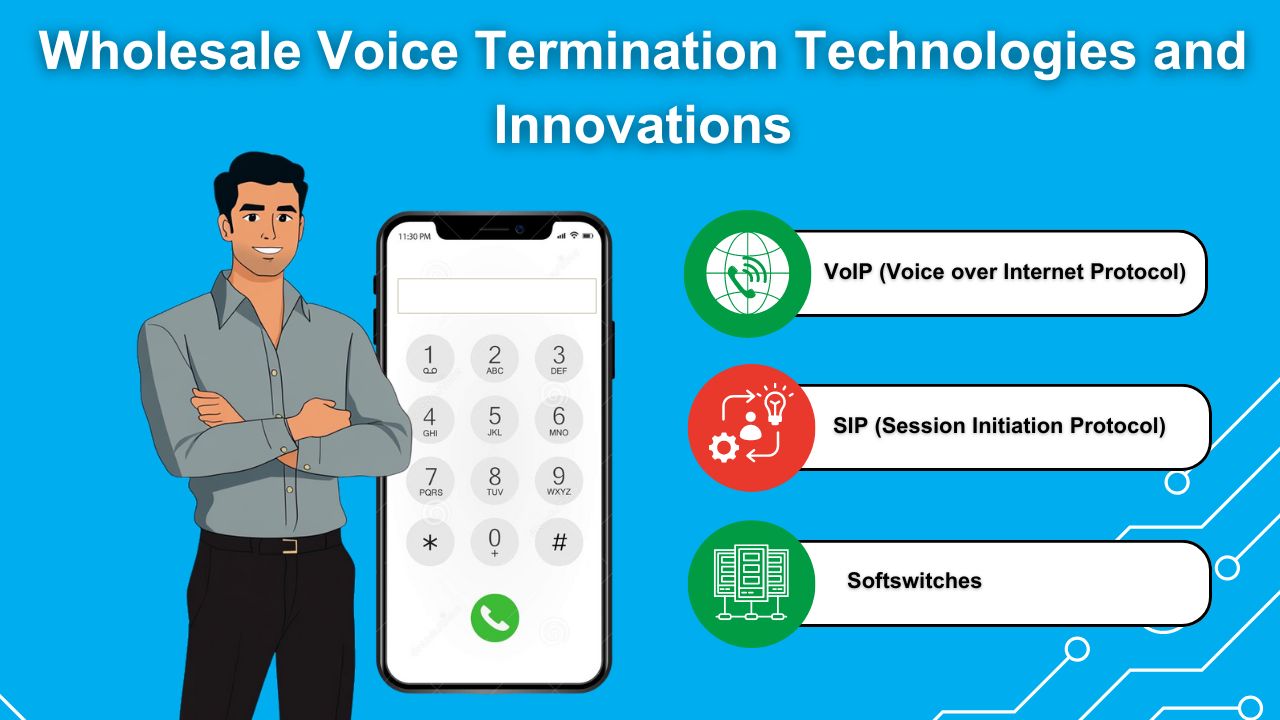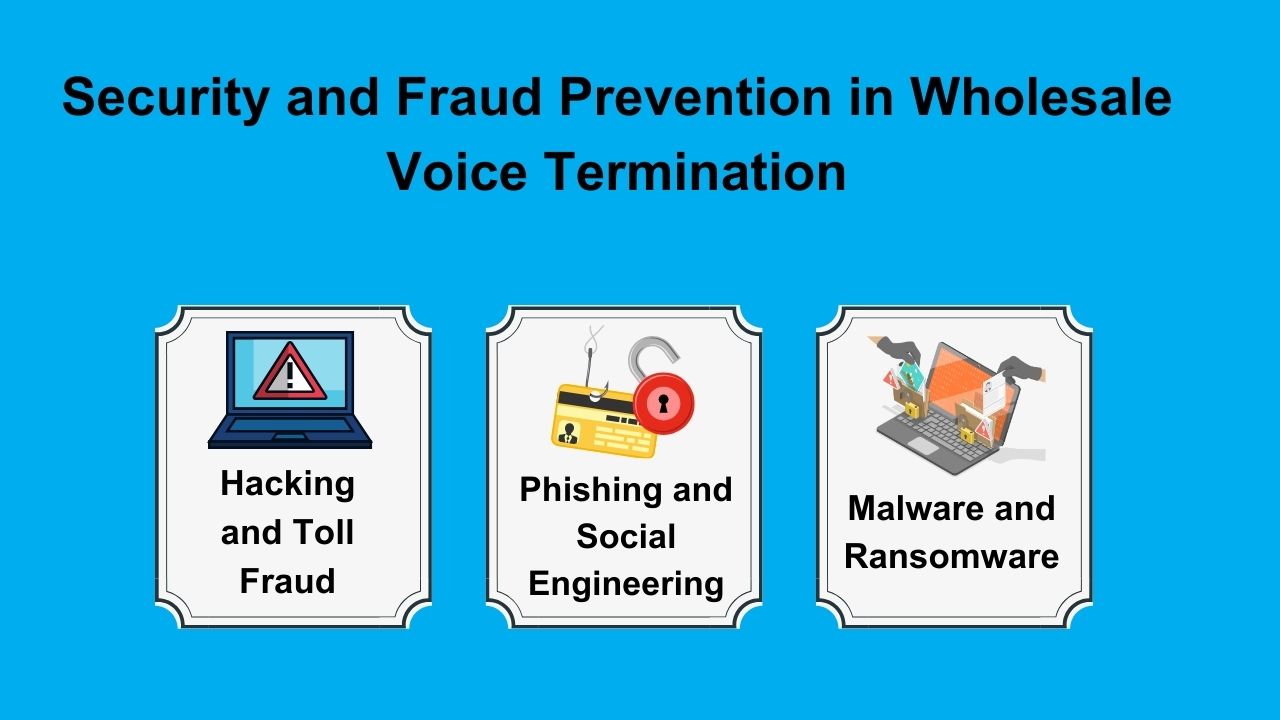Introduction
Wholesale voice termination is a critical component of modern business communication, enabling companies to manage their voice traffic efficiently and cost-effectively. This process involves routing and terminating voice calls through a network of providers at wholesale rates, allowing businesses to benefit from lower costs and greater flexibility. Wholesale voice termination is essential in business communication as it enables companies to manage high volumes of voice traffic while reducing communication expenses. It also enhances flexibility and scalability, allowing businesses to adapt to changing demands. By leveraging wholesale voice termination, businesses can improve call quality and reliability, ensuring clear and uninterrupted communication.How Wholesale Voice Termination Works
 Wholesale voice termination involves a complex process of routing and terminating voice calls through a network of providers, ensuring that communication is both efficient and cost-effective for businesses. The process begins when a call is initiated on the originating network, such as a corporate phone system or a call center, and it needs to be connected to the recipient on the terminating network.
Wholesale voice termination involves a complex process of routing and terminating voice calls through a network of providers, ensuring that communication is both efficient and cost-effective for businesses. The process begins when a call is initiated on the originating network, such as a corporate phone system or a call center, and it needs to be connected to the recipient on the terminating network.
Network Architecture and Infrastructure
Specialized telecommunication carriers maintain a robust network infrastructure to support high volumes of voice traffic.This network includes multiple data centers, switches, and routers, designed to handle the demands of modern business communication.- Network includes multiple data centers, switches, and routers
- Redundant infrastructure ensures maximum uptime and reliability
Call Routing and Termination
The process of call routing and termination involves directing voice calls through the provider’s network to their final destination. Calls are routed efficiently to ensure the best rates and quality, often passing through multiple providers.- Calls are routed through the provider’s network to the final destination
- Calls may be routed through multiple providers to ensure best rates and quality
Quality of Service (QoS) and Security Measures
Telecom network operators implement Quality of Service (QoS) measures to deliver high-quality voice services. QoS ensures that voice calls have priority over other types of data, reducing latency and packet loss.- Security measures include encryption, firewalls, and access controls
- Providers comply with industry regulations and standards
Benefits of Wholesale Voice Termination

Cost Savings
Carrier-grade voice services provide significant cost savings for businesses by offering reduced rates for voice traffic.Companies benefit from lower costs per minute for both domestic and international calls, allowing them to connect with clients and partners globally without the high expenses associated with traditional telephony systems.- Reduced rates for voice traffic
- Lower costs per minute for domestic and international calls
Scalability and Flexibility
A key advantage of carrier-grade voice solutions is their scalability and flexibility.Businesses can easily scale their voice services up or down to meet changing needs, whether expanding operations or adjusting to market fluctuations. The flexibility to route calls through multiple providers ensures optimal call quality and cost-effectiveness. Furthermore, these voice solutions integrate seamlessly with existing infrastructure, allowing businesses to enhance their communication systems without extensive modifications.Reliability and Uptime
Reliable voice connectivity solutions ensure high-quality voice services with minimal downtime, which is crucial for maintaining effective communication. Providers offer redundant infrastructure to maximize uptime and ensure continuous service availability. Proactive monitoring and maintenance practices further enhance performance by identifying and addressing potential issues before they affect operations.- High-quality voice services with minimal downtime
- Redundant infrastructure for maximum uptime
Choosing the Right Wholesale Voice Termination Provider
 Selecting the right business voice services partner is a critical decision that can significantly impact your business communication capabilities. The right partner ensures that your voice services are not only reliable and high-quality but also cost-effective, enabling your business to maintain smooth and efficient operations. An ideal partner will offer a robust network infrastructure, excellent call quality, and a range of features tailored to meet your specific business needs. Furthermore, they should provide scalable solutions that can grow with your business, as well as comprehensive support and maintenance to address any issues promptly.
Selecting the right business voice services partner is a critical decision that can significantly impact your business communication capabilities. The right partner ensures that your voice services are not only reliable and high-quality but also cost-effective, enabling your business to maintain smooth and efficient operations. An ideal partner will offer a robust network infrastructure, excellent call quality, and a range of features tailored to meet your specific business needs. Furthermore, they should provide scalable solutions that can grow with your business, as well as comprehensive support and maintenance to address any issues promptly.
Factors to Consider
- Reputation and Reliability: Research the provider’s reputation, reliability, and uptime
- Network Quality and Coverage: Evaluate the provider’s network quality, coverage, and reach
- Pricing and Plans: Compare pricing models, plans, and rates among providers
- Features and Functionality: Consider the provider’s features, functionality, and customization options
- Support and Maintenance: Evaluate the provider’s support, maintenance, and troubleshooting capabilities
Optimizing Wholesale Voice Termination Services
 Optimizing global voice connectivity services involves strategically managing voice traffic routing, carrier selection, and pricing to achieve maximum efficiency and cost-effectiveness. By leveraging advanced routing algorithms, real-time network monitoring, and robust quality assurance measures, service providers can deliver high-quality voice connections while minimizing termination costs.
Optimizing global voice connectivity services involves strategically managing voice traffic routing, carrier selection, and pricing to achieve maximum efficiency and cost-effectiveness. By leveraging advanced routing algorithms, real-time network monitoring, and robust quality assurance measures, service providers can deliver high-quality voice connections while minimizing termination costs.
Monitoring and Maintenance
Effective monitoring and maintenance are critical for ensuring the reliability and performance of your voice services. Regularly monitor call quality, uptime, and other performance metrics to identify and address any issues proactively. Collaborate with your provider to perform routine maintenance and troubleshooting, ensuring that your communication systems remain in optimal condition.Troubleshooting and Support
Establishing a clear support process with your provider is essential for efficiently addressing any technical issues that may arise. Define escalation procedures for critical issues to ensure they are resolved promptly and effectively, minimizing any impact on your business operations. Consider proactive monitoring and alerting systems that can identify potential issues before they escalate, allowing for quicker response times and reducing downtimeScalability and Flexibility
Scalability and flexibility are vital for accommodating future growth and changing business needs. Work with your provider to plan for scalability, ensuring that your communication systems can easily expand as your business grows. Evaluate flexible pricing models and plans that allow for adjustments in services and costs based on your evolving requirements.Challenges and Solutions in Wholesale Voice Termination
 Wholesale voice termination presents several challenges that businesses must navigate to ensure reliable and high-quality voice services. Below, we explore common challenges and potential solutions to address them.
Wholesale voice termination presents several challenges that businesses must navigate to ensure reliable and high-quality voice services. Below, we explore common challenges and potential solutions to address them.
Quality of Service (QoS) Issues:
One of the primary challenges in delivering high-quality voice services is maintaining a high Quality of Service (QoS). Problems such as poor call quality, latency, and packet loss can significantly affect the end-user experience. These issues can stem from network congestion, inadequate bandwidth, or suboptimal routing configurations.Dropped Calls and Disconnects:
Dropped calls and unexpected disconnects are another prevalent issue. Frequent interruptions can be attributed to various factors, including network instability, configuration errors, or issues with the terminating carrier. These disruptions can harm customer satisfaction and affect the reputation of the service provider.Billing and Settlement Disputes:
Billing inaccuracies and settlement disputes are common in global voice trade. Discrepancies between agreed-upon rates and actual charges, as well as misunderstandings about billing practices, can lead to conflicts and financial losses. Effective management of billing and settlement processes is crucial to maintaining healthy business relationships.Wholesale Voice Termination Technologies and Innovations
 The wholesale voice termination landscape is evolving rapidly due to technological advancements and innovations. This section explores both current technologies and emerging trends that are shaping the industry.
The wholesale voice termination landscape is evolving rapidly due to technological advancements and innovations. This section explores both current technologies and emerging trends that are shaping the industry.
VoIP (Voice over Internet Protocol)
VoIP technology enables voice calls to be made over Internet Protocol (IP) networks, allowing for cost-effective and flexible communication. It has transformed the telecommunications industry by reducing the need for traditional telephone infrastructure and offering improved scalability and integration capabilities.- Scalability: Easily adapts to the changing needs of businesses, allowing for seamless expansion.
- Advanced Features: Offers a range of features like call forwarding, voicemail, and conference calling.
SIP (Session Initiation Protocol)
SIP is a signaling protocol used to set up, manage, and terminate voice calls over IP networks. It is a critical component of VoIP systems, facilitating seamless communication between different devices and networks.- Interoperability: Ensures seamless communication between different devices and networks.
- Flexibility: Allows for easy integration with existing systems and applications.
Softswitches
Softswitches are software-based switches that handle call routing and management within a network. They replace traditional hardware switches, providing greater flexibility and scalability. Softswitches support various communication protocols and are integral to managing VoIP traffic, enabling efficient and reliable call processing.Security and Fraud Prevention in Wholesale Voice Termination
 Security and fraud prevention are critical concerns in global voice communications, as businesses must protect themselves and their customers from various threats. The increasing reliance on digital communication networks has heightened the need for robust security measures to safeguard against cyber threats, unauthorized access, and financial fraud. In this section, we will explore common security threats and measures to prevent fraud, as well as best practices for maintaining a secure communication environment.
Security and fraud prevention are critical concerns in global voice communications, as businesses must protect themselves and their customers from various threats. The increasing reliance on digital communication networks has heightened the need for robust security measures to safeguard against cyber threats, unauthorized access, and financial fraud. In this section, we will explore common security threats and measures to prevent fraud, as well as best practices for maintaining a secure communication environment.
Hacking and Toll Fraud
Hacking and toll fraud involve unauthorized access to communication networks and systems, allowing attackers to exploit vulnerabilities for financial gain. Toll fraud can result in substantial financial losses for service providers, as fraudsters make unauthorized calls that are billed to the provider.- Unauthorized Access: Hackers exploit network vulnerabilities to gain access to sensitive systems and data.
- Financial Impact: Toll fraud leads to unexpected charges and revenue losses for businesses.
- Data Breaches: Compromised systems can result in the theft of confidential customer information.
Phishing and Social Engineering
Phishing and social engineering attacks manipulate individuals into disclosing sensitive information, such as login credentials and personal data. Attackers often use deceptive emails, messages, or phone calls to trick individuals into revealing confidential information.- Deceptive Communication: Attackers impersonate legitimate sources to gain trust and extract information.
- Information Theft: Victims may unknowingly provide access to sensitive data, compromising network security.
Malware and Ransomware
Malware and ransomware attacks involve the installation of malicious software on network systems, compromising data integrity and availability. Ransomware encrypts data and demands a ransom for its release, posing significant threats to business continuity.- System Infiltration: Malware infects systems, leading to data corruption and unauthorized access.
- Data Encryption: Ransomware locks critical data, demanding payment for decryption keys.
Conclusion
Effective voice connectivity management is a complex and rapidly evolving field, playing a crucial role in the success of businesses that rely on voice communications. It enables businesses to efficiently manage and route calls, offering a range of benefits while also presenting certain challenges. In this guide, we have explored the ins and outs of optimizing global voice services, including its benefits, challenges, and best practices. As the telecommunications industry continues to evolve, understanding and leveraging these aspects will be essential for businesses seeking to optimize their communication strategies.FAQ'S
Wholesale voice termination is the process of routing and terminating voice calls through a network of providers at wholesale rates, enabling businesses to manage voice traffic efficiently and cost-effectively.
Wholesale voice termination provides significant cost savings, scalability, and flexibility, enabling businesses to manage high volumes of voice traffic while reducing communication expenses.
When choosing a provider, consider reputation, network quality, pricing, features, and support to ensure reliable and high-quality voice services.
Common security threats include hacking, toll fraud, phishing, social engineering, malware, and ransomware, which can compromise network security and lead to financial losses.
Businesses can optimize services by strategically managing voice traffic routing, carrier selection, and pricing, while also monitoring and maintaining network performance to ensure high-quality voice connections.





